September 11th, 2008 admin
As I mentioned in an earlier post, Tom Stoddart is working on a long term project called This England. We’re also joined by photographer Andy Greaves who is working on a documentary about England for his MA course. You can see a few initial images from his project, called ‘England, My England’, on his website here. I look forward to seeing how it progresses.
Posted in MISCELLANEOUS | Comments Off on ENGLAND, MY ENGLAND
September 7th, 2008 admin
We’re heading home!Â
Having made it to the England-Scotland border just north of Berwick-upon-Tweed we’re now going to spend the next seven days driving down the historic A1 to London then on to Brighton. Up until now we’ve made very few journey’s via motorways, preferring to take more minor (and therefore slower) roads, but it seems apt to finish the trip following the route of the Great North Road – which the modern A1 mainly follows.
The Great North Road was a major coaching route in Britain and was used by the mail coaches between London, York and Edinburgh. It is often mentioned in English literature, for example Pickwick Papers by Charles Dickens. The modern course of the A1 diverges somewhat from the Great North Road, particularly where it passed through a town or village that has subsequently been bypassed, or where new motorway standard road has been constructed on a more direct route.Â
The A1 is the longest numbered road in the UK at 409 miles (658km) long and connects the capital of England (London) with the capital of Scotland (Edinburgh). It was once the busiest motorway in the country with an active roadside economy of shops, cafes, hotels. In the 1950s it was supplanted by the newly constructed M1 a speedier and smoother motorway for an England moving slickly into a modernity of effeciency and consumerism.Â
Â
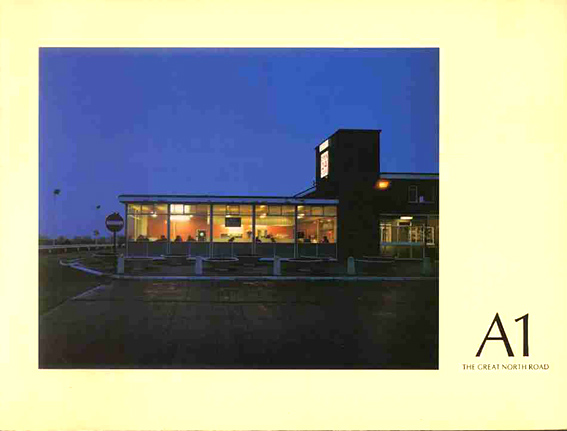
Â
Photographically, the A1 is most readily associated with the work of British photographer Paul Graham. Graham spent two years photographing along the route of the A1 with a large format camera. The work was eventually published in 1983. A1 —The Great North Road was Graham’s first book and contained 41 color reproductions.
Â
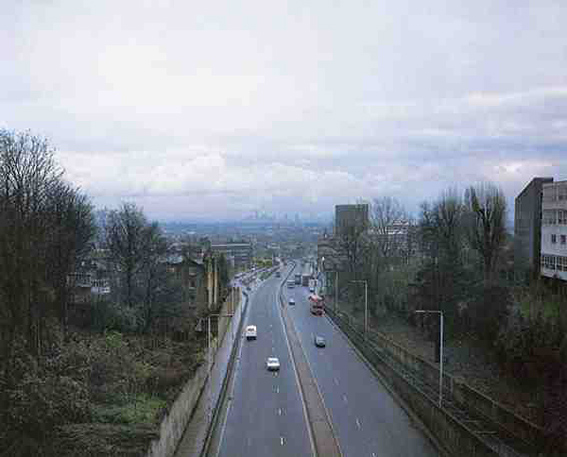
© Paul Graham, 1983
The photographs are a mournful document of a grey nowhere land in a country moving too fast to stop for a cup of tea. The book is now a valuable collectors item, valued at over £250, not bad for a self-published paper back! I’ve posted up a couple of the pictures from the book here, but you can see more on Graham’s website.
Â
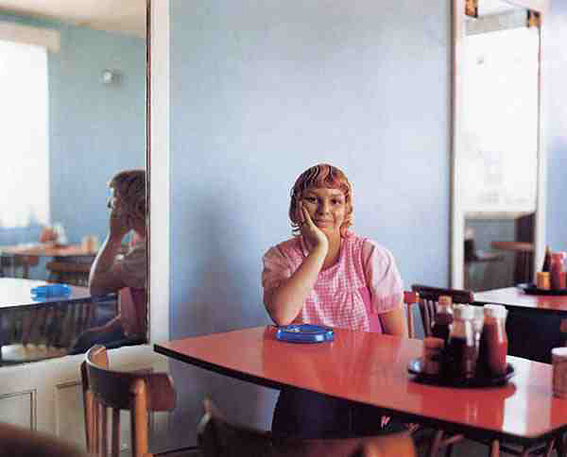
© Paul Graham, 1983
According to many commentators, Graham’s A1 photographs had a transformative effect on the black and white tradition that had dominated British art photography till that point. This work, along with Graham’s later photographs of the 1980s – the colour images of unemployment offices in Beyond Caring (1984-85), and the sectarian marked landscape of Northern Ireland Troubled Land (1984-86) – were pivotal in reinvigorating and expanding this area of photography, by both broadening it’s visual language, and questioning our notions of what such photography could say, be, or look like.   Photographers like Martin Parr made the switch to colour soon after, and a new school of British Photography evolved with the subsequent colour work of Richard Billingham, Tom Wood, Paul Seawright, Anna Fox, among others.
Â
Posted in INSPIRATION, PLACES, TRIP LOGISTICS | 5 Comments »
September 6th, 2008 admin
Now that my journey across England is nearing an end, I wanted to look at the notion of the road trip in photography. While I’ve already touched on the timeline of British photographers who have used the road trip as a vehicle for documenting England/Britain, I want to now turn my attention to the work of American photographers. I’ll do this over several blog entries (I will look at European photographers in a future post).
Highway culture has long been a quintessential part of American identity and is also reflected in the canon of contemporary American photography who have worked within the tradition of the road trip across America. Names such as Jeff Brouws, Tim Davis, William Eggleston, Mitch Epstein, Robert Frank, Lee Friedlander, Todd Hido, Dorothea Lange, Ed Ruscha, Lise Sarfati, Stephen Shore, Rosalind Solomon, Alec Soth, Mark Steinmetz, Joel Sternfeld, and Garry Winogrand and others, have all embraced the genre. Several of whom have been major influences in my own work (particularly in Motherland), notably the work of Stephen Shore and Joel Sternfeld.
By way of an introduction to the genres I’m posting up details of an exhibition that was held at the Yancey Richardson Gallery last summer called Easy Rider: Road Trips Through America, which focussed on the road trip in American photography.
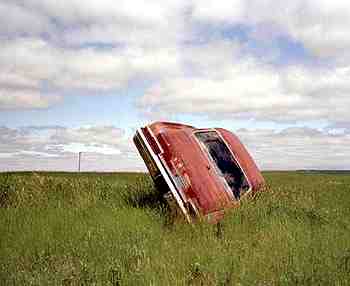
Jeff Brouws, Route 248, Four Buttes, Montana, 2004
The following text is taken from the Easy Rider exhibition press release-
“Easy Rider explores the common themes of social commentary, cultural geography and photographic biography produced by the marriage between the road and photography. Included are photographs and videos dating from 1935 to 2006.
The road allowed Farm Security Administration photographers Dorothea Lange and Walker Evans to document the plight of Americans suffering floods and dustbowls during the Great Depression. Similarly bleak, Robert Frank’s mid 1950s road trips yielded a portrait of the nation at odds with the projected optimism of the era and culminated in The Americans, a landmark publication, which influenced generations of later photographers.
The open road as a symbol of freedom is exemplified in Allen Ginsberg’s 1964 shot of Neal Cassady at the wheel of Ken Kesey’s Merry Prankster bus; Cassady’s incessant cross-country journeys were a primary inspiration for Jack Kerouac’s definitive Beat generation novel On the Road. Having spent four years riding with the motorcycle gang the Outlaws, Danny Lyons produced the book The Bikeriders, which emblazoned motorcycle counterculture onto the American psyche and inspired the film Easy Rider.
Subsequent generations of photographers continued to take to the road in order to explore the cultural landscape. Traveling on a 1969 Guggenheim to study the effect of the media on public events, Garry Winogrand recorded America’s restlessness through its political rallies, peace demonstrations and space shuttle launches. In the 1970s Mitch Epstein looked at recreation across America while Joel Sternfeld’s wryly-funny photographs often showed man at odds with nature. Alec Soth followed the watery artery of the Mississippi River to make pictures of the dreams; both lost and fiercely held, of those he encountered. More recently, Tim Davis traveled the country to seek out the presence of politics in today’s life; in St. Louis he found a wall mural of the United States depicted as one grotesquely stretched red state.
Several photographers have looked closely at the details and detritus of American culture for clues to its soul. William Eggleston’s photograph of an elegantly wallpapered restaurant wall plastered over with the business cards of its patrons shows commercial aspirations trumping style. On the bare chipboard walls of Reverend and Margaret’s Bedroom, Soth memorializes a moving display of family photographs while Lisa Kereszi’s discovery of a biker bar’s photographic collage of women flashing their breasts reveals the misogynist underbelly of road-worshipping motorcycle culture.
Many photographers have constructed a kind of biography of roads traveled, places visited and people encountered, often including themselves and family m embers. In 1962, Ed Ruscha photographed isolated gas stations along Route 66 filling half the picture frame with the street at his feet. Lee Friedlander frequently incorporated himself into his car images, staring into the camera through the windshield or via the side view mirror. In his witty series America and Me, recent Bard graduate William Lamson photographed himself interacting with elements of the roadside landscape, always hiding his face but freely revealing the shutter release. Poolside at a roadside inn, Stephen Shore incorporated his young wife Ginger into a minimalist composition of color and light. Accustomed to working on the road, Justine Kurland adjusted to motherhood by photographing her young son living with her in a camper van on an extended road trip.
Jeff Brouws has made a career of photographing along highways, evolving from cataloguing the relics of small town roadside architecture to documenting the negative impact of thruways in the 21st century. His 2004 image of a rusting red car upended in a field presents a pessimistic view of contemporary road culture: the car as a dinosaur on the road to nowhere.”
My subsequent posts will look at the work of individual photographers.
Posted in EASY RIDER, INSPIRATION | Comments Off on EASY RIDER – TRAVELS THROUGH AMERICAN PHOTOGRAPHY PART 1
September 6th, 2008 admin
We took a brief diversion this weekend to attend my cousin’s wedding in Edinburgh. Driving north on the A1 from Berwick it was intriguing to see the different ways that England and Scotland mark their border posts. As you head north drivers are met with a large, clear sign based on the Scottish flag, which welcomes you to Scotland. It could be seen from a distance, even in the pouring rain.Â
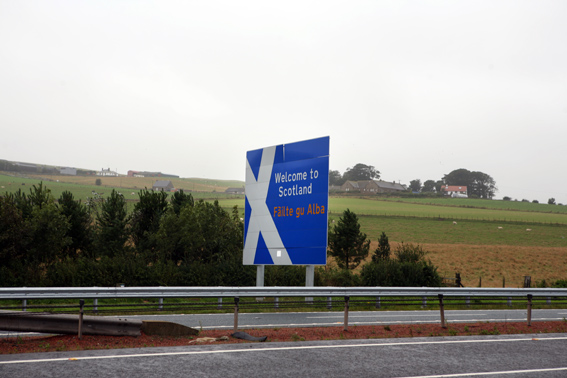
Â
Driving south a couple of days later, in similarly depressing weather conditions, I only just spotted our border post. A rather pathetic stone block, covered in lichen, with the barely readable words ‘England’. Â
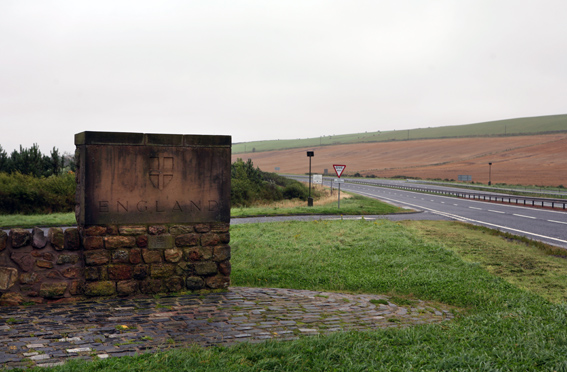
Â
Are there conclusions to be drawn from these contrasting declarations of identity?!
Â
Posted in MISCELLANEOUS | 1 Comment »
September 4th, 2008 admin
Spent the day in the Northumberland coastal town of Seahouses….
Â
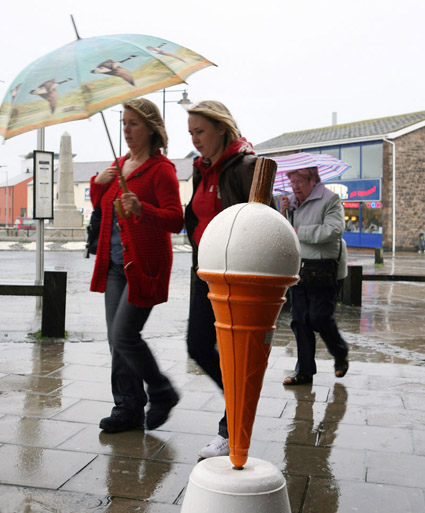
Â
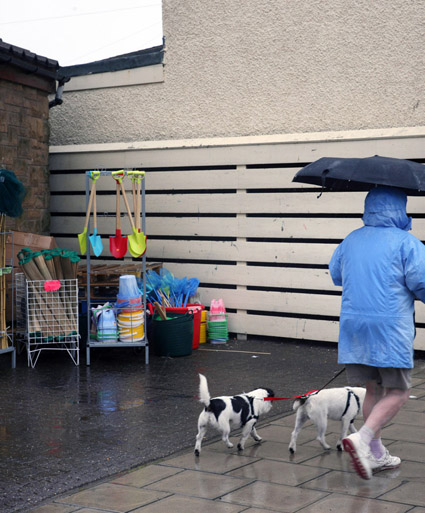
Posted in POSTCARDS | Comments Off on SUMMER IN SEAHOUSES
September 4th, 2008 admin
After an unsettled night free-camping in Carlisle’s Rickerby Park, where we inadvertently found ourselves parked near a road favoured by the cities boy-racers (it was 11.30pm and too late to move!), we’re now driving through the county of Northumberland.Â
Once part of the Roman Empire and the scene of many wars between England and Scotland, Northumberland has a long and violent history. The bloodiest battle currently taking place in the county (well in Tyne & Weir which was historically part of Northumberland) appears to be at Newcastle United FC where the club’s fans have declared war on Mike Ashley, Newscatle’s owner, over the forced departure of coach Kevin Keegan. Such is the passion that football stirs amongst Tyneside fans.
We’ll be spending the remainder of the week in the county driving along Hadrian’s Wall, stopping off at Kielder Water (the largest man-made lake in Western Europe) then heading north up the coast to our final destination of Berwick-upon-Tweed near the border with Scotland.
Â
Posted in PLACES, TRIP LOGISTICS | Comments Off on BOY RACERS & BLOODY BATTLES
September 1st, 2008 admin
Monday morning and another batch of film has gone off to Spectrum Photographic for processing. It’s always a nerve-racking wait to hear that a. the post office haven’t lost the film and b. that there’s something on the negatives!
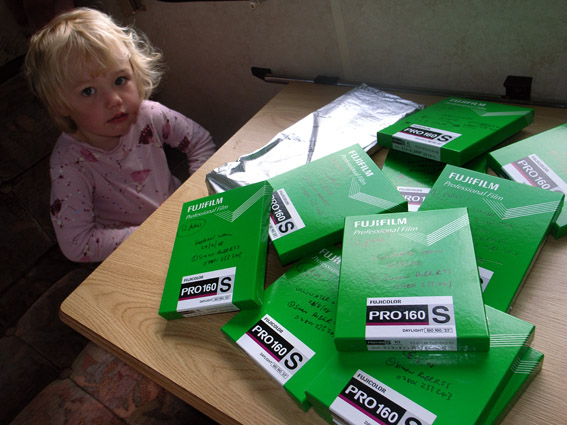
I’ve not seen any of the material I’ve shot since leaving Brighton in May, bar ten contact sheets, which were sent to me early on in the trip. While this is somewhat of a strange scenario in our digital age, where photographers are used to seeing images almost instanteously, I’m actually unphased by it and actually work better for it. It was the same during the production of Motherland where I would only get film processed once every three months on a brief return to Moscow.
Over the past four months I’ve been satisfied with just a phone call from the lab briefing me that the films are well exposed and in focus (thankfully the case most of the time!). Saying that, I am looking forward to pouring over the contact sheets when I return to Brighton in mid September.
Â
Posted in TRIP LOGISTICS | Comments Off on FILM UNSEEN
September 1st, 2008 admin
Continuing my weekly dispatch in The Times, week 14 was taken at Ennerdale and Kinniside Show, Cumbria.
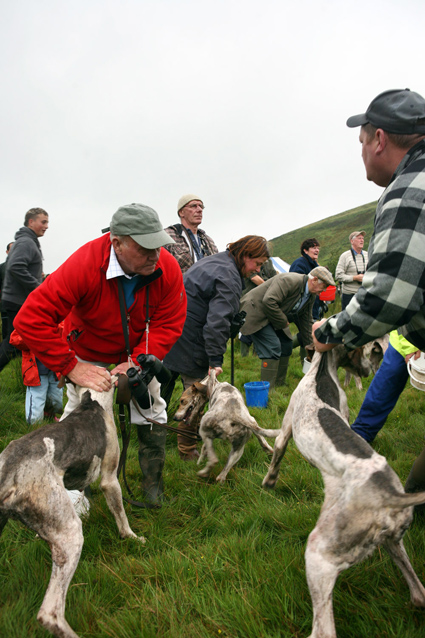
Ennerdale and Kinniside Show, Ennerdale, Cumbria, 27th August 2008
Owners retrieve their hounds on the finish line after a race at the Ennerdale and Kinniside Show. Although sometimes referred to as ‘the poor man’s fox hunting’, hound trailing is one sport that may be said to challenge wrestling and fell running for the affection and loyalty of Cumbrians. Rarely seen outside of the county, hound trailing has no long history yet it has become one of the most characteristic sporting events in the Lake District social calendar.
This week we’ll be in Northumbria.
Â
Posted in EVENTS & PASTIMES, POSTCARDS | Comments Off on POSTCARD IN THE TIMES – WEEK 14
Although some marketing body has come up with the superficial branding of the Lake District as Wordsworth Country, and hordes of tourists flock to Dove Cottage every year, please permit me to post an extract from William Wordsworth’s poem The Prelude (Book 1).Â
As Sister Wendy Beckett writes in her collection of poetry Speaking to the Heart, this is Wordsworth at his most true and responsive to the numinous of his beloved Lake District. “Anyone who has stood alone and in silence, above all in the early morning or at night, knows the mysterious power of hills and water. Wordsworth stands alone in finding a voice for these almost indescribable feelings” writes Beckett in the introduction to the poem.
Â
An extract from The Prelude (Book 1) by William Wordsworth
             A rocky Steep uprose
Above the Cavern of the Willow tree,
And now, as suited one who proudly rowed
With his best skill, I fixed a steady view
Upon the top of that same craggy ridge,
The bound of the horizon – for behind
Was nothing but the stars and the grey sky.
She was an elfin Pinnace; lustily
I dipp’d my oars into the silent Lake,
And, as I rose upon the stroke, my Boat
Went heaving through the water, like a Swan –
Â
When, from behind that craggy Steep (till then
The bound of the horizon) a huge Cliff,
As if with voluntary power instinct,
Uprear’d its head. I struck, and struck again
And, growing still in stature, the huge Cliff
Rose up between me and the stars, and still,
With measur’d motion, like a living thing,
Strode after me. With trembling hands I turn’d,
And through the silent water stole my way
Back to the Cavern of the Willow tree.
There, in her mooring-place, I left my Bark,
And, through the meadows homeward went, with grave
And serious thoughts; and after I had seen
That spectacle, for many days, my brain
Work’d with a dim and undetermined sense
Of unknown modes of being; in my thoughts
There was a darkness, call it solitude,
Or blank desertion, no familiar shapes
Of hourly objects, images of trees,
Of sea or sky, no colours of green fields;
But huge and mighty Forms that do not live
Like living men mov’d slowly through the mind
By day and were the trouble of my dreams.
Â
You can read the entire poem here.
Â
Posted in INSPIRATION | Comments Off on A POEM FROM WORDSWORTH COUNTRY
Although the exhibition ends today, I wanted to give a quick plug for Henry Iddon’s photographs taken in the Lake District. Spots of Time have been on display at the Wordsworth Trust gallery at Dove Cottage, Grasmere, since March 2008.
Blackpool-based photographer Iddon spent 18 months perched on fell tops throughout the night to capture the effects of artificial light at different times and seasons. Bright clusters of streetlamps and house lights dot the unusual images of the English Lake District, with the wider orange glow of major towns such as Barrow-in-Furness diffusing the night sky behind.
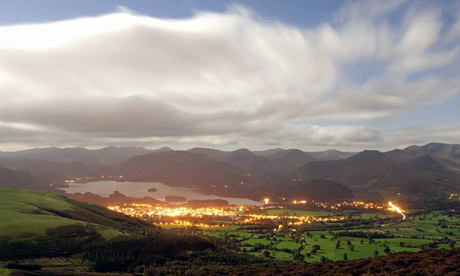
Keswick and Derwent Water seen from the slopes of Skiddaw taken at 11.22pm, when sunset was 7pm. © Henry Iddon
Lord Smith of Finsbury, chair of the Wordsworth Trust and former Culture Secretary, said that the photographs achieved the unusual feat of seeing one of Britain’s most exhaustively recorded landscapes through new eyes. He said: “They show us the bright, glowing, night-time impact of humankind, but set within the immensity of the broader landscape. No-one can look at them without being moved to ponder on the relationship of reverence and of interdependence that we ought to foster with the natural world around us.”
Don’t worry if you don’t make it to the exhibition today – I felt the lighting in the gallery really let the prints down – Iddon has produced an impressive website for the project. View it here.
Â
Posted in MISCELLANEOUS | Comments Off on SPOTS OF TIME BY HENRY IDDON












